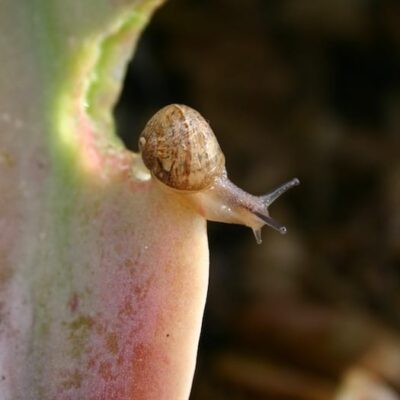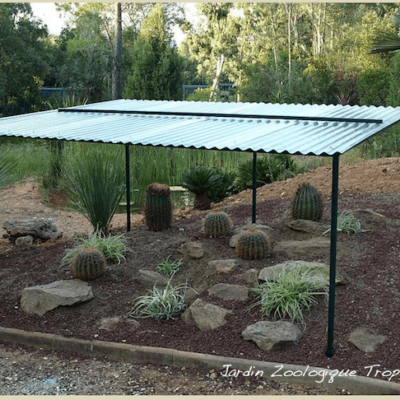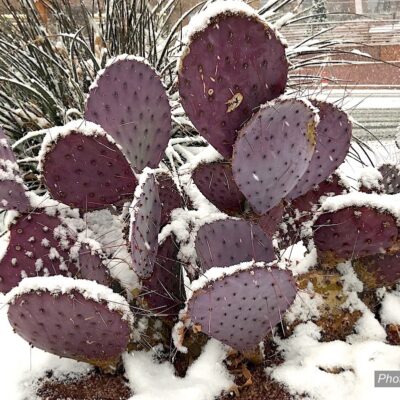Succulents from South Africa and Madagascar (such as aloes, jade and kalanchoes) thrive along the California coast because the climate and weather patterns are similar to those of their native habitats.
The farther you go inland, like my own garden---at 1500 feet in the foothills NE of San Diego---it gets too cold in the winter and too hot in the summer for many soft succulents (as opposed to agaves and cacti).
If I can do it, so can you
Yet without difficulty, I grow hundreds of species---nearly all those I show throughout this site and in my three books on succulents. How? Basically I understand my terraced half-acre's microclimates and position plants accordingly. (And I have a few other tricks up my sleeve.)
Even closer to the coast, you'll contend with changing weather patterns that provide less or more rain than these water-storing plants need.
The info on this page will help you get your chubbies through rainstorms without rotting. Here too are essentials about drainage, frost and hail.
The video above is one of several I've made about winter weather and succulents. Scroll down for other videos you'll find helpful.
After rainstorms, check for:
-- Succulents with rotted leaves. Remove mushy leaves before rot spreads to the plant's stem or crown.
-- Drainage issues. If soil stays sodden and muddy areas remain long after a storm, roots may drown. Move plants to higher ground. Install French drains.
-- Slope erosion. Create dams of rocks and diversion channels, and top-dress the soil with gravel or mulch to diffuse the rain's impact.
-- Stagnant water. Check pots, bins and barrels. If they've filled, dump the water before mosquitos find it and breed.
-- Weeds. Wherever soil is exposed to sun, weeds WILL sprout. Get them when small. All too soon they'll have deep roots, go to seed, and look you in the eye.
-- Hail damage. White dots from the impact of tiny bits of ice appear on upper leaves. Spring growth usually covers them.
-- Seepage. Check your home’s basement. Mine used to have an inch or two of standing water whenever the ground became saturated during storms. A few years ago, a friend suggested a simple solution: Coat the concrete blocks that form the basement’s walls with a special paint that prevents seepage. Works great. Any home improvement store carries it.
-- Shop for plants. Now’s a good time to accumulate plants you want to add to your garden. Rain-soaked ground is soft and easy to dig. Early spring is the best time to establish new plants, after all danger of frost has passed (here in Southern CA, mid-March). Plants will take off in spring and don’t have to contend with summer heat while putting down roots. Don't delay; if your garden is like mine, when the soil dries, it becomes hard as concrete.
-- Take photos as what-to-do reminders. When the weather clears, such issues are easy to forget.
The good news: Succulents tend to be opportunistic when it comes to rain. Given adequate drainage and frost protection, they love it!
When Frost Follows
Frost may settle in low-lying areas on cold, clear nights after a storm. If temps are forecast to drop into the low 30sF, cover vulnerable non-native succulents (aloes, aeoniums, crassulas, kalanchoes, euphorbias) with bedsheets.
Better yet, use a lightweight, non-woven fabric ("frost cloth," "floating row cover"). Keep in mind succulents open to the sky are more vulnerable than those along walls or beneath eaves and trees.
Related VIDEOS
Why Succulents Rot and How to Prevent It
The Squish Test for Succulents
Worried your succulents are getting too much water? Here's how I test and rescue succulents after rainstorms. Even if soft and squishy means rot, it's not always too late.
Post-Rain Must-Do's for Succulent Gardens
Have you checked your succulent garden after the rainstorms? I found a few things that needed taking care of and I bet you will, too!
Protect Your Succulents from Frost
Follow me through my own garden as I select and protect cold-sensitive succulents.
MORE Info on This Site
How Rain Benefits Succulents
Here’s how rain benefits succulents: It provides dissolved minerals and washes away dust that inhibits photosynthesis; it dilutes and flushes salts and harmful chemicals that have built up in the soil from tap water; and it provides nitrogen essential to growth,
Prepare Your Succulents for Rainstorms
During rainy weather, succulents, which come from arid climates, may rot. Stems or trunks turn squishy and collapse. It may be possible to take cuttings from healthy top growth and restart the plants—as I did after one rainy winter with aeoniums. Fortunately, the rest of my succulents came through fine, despite double normal rainfall. After…
Succulents and Too Much Rain, A French Solution
Want to protect your succulents from too much rain? Here’s how the Jardin Zoologique Tropical in southeastern France keeps their succulents from becoming waterlogged during seasonal rainstorms. Corrugated fiberglass panels atop metal bars tent the plants so excess rain doesn’t soak the soil. The structures are tall enough to allow good air circulation, and the panels are translucent, enabling maximum sunlight to reach the plants. The…
Winter Care for Frost-Tender Succulents
Depending on where you live, here’s how to get frost-tender South African succulents—like crassulas (jades), euphorbias, senecios and aloes—through a North American winter.
The post Protect Your Succulents From Rain, Hail, Frost appeared first on Debra Lee Baldwin. Copyright © Debra Lee Baldwin.
from Debra Lee Baldwin https://ift.tt/9jkpgue
via IFTTT





No hay comentarios:
Publicar un comentario